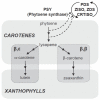Phytochemicals in Daucus carota and Their Health Benefits-Review Article
- PMID: 31546950
- PMCID: PMC6770766
- DOI: 10.3390/foods8090424
Phytochemicals in Daucus carota and Their Health Benefits-Review Article
Abstract
Carrots are a multi-nutritional food source. They are an important root vegetable, rich in natural bioactive compounds, which are recognised for their nutraceutical effects and health benefits. This review summarises the occurrence, biosynthesis, factors affecting concentration, and health benefits of phytochemicals found in Daucus carota. Two hundred and fifty-five articles including original research papers, books, and book chapters were analysed, of which one hundred and thirty articles (most relevant to the topic) were selected for writing the review article. The four types of phytochemicals found in carrots, namely phenolics, carotenoids, polyacetylenes, and ascorbic acid, were summarised. These chemicals aid in the risk reduction of cancer and cardiovascular diseases due to their antioxidant, anti-inflammatory, plasma lipid modification, and anti-tumour properties. Numerous factors influence the amount and type of phytochemicals present in carrots. Genotype (colour differences) plays an important role; high contents of α and β-carotene are present in orange carrots, lutein in yellow carrots, lycopene in red carrots, anthocyanins in the root of purple carrots, and phenolic compounds abound in black carrots. Carotenoids range between 3.2 mg/kg and 170 mg/kg, while vitamin C varies from 21 mg/kg to 775 mg/kg between cultivars. Growth temperatures of carrots influence the level of the sugars, carotenoids, and volatile compounds, so that growing in cool conditions results in a higher yield and quality of carrots, while higher temperatures would increase terpene synthesis, resulting in carrots with a bitter taste. It is worthwhile to investigate the cultivation of different genotypes under various environmental conditions to increase levels of phytochemicals and enhance the nutritional value of carrot, along with the valorisation of carrot by-products.
Keywords: ascorbic acid; carotenoids; carrot; human health; phenolic compounds; polyacetylenes.
Conflict of interest statement
The authors declare no conflict of interest.
Figures







References
-
- Tiwari U., Cummins E. Factors influencing levels of phytochemicals in selected fruit and vegetables during pre-and post-harvest food processing operations. Food Res. Int. 2013;50:497–506. doi: 10.1016/j.foodres.2011.09.007. - DOI
-
- Food and Agriculture Organization of the United Nations Carrots and Turnips. [(accessed on 10 July 2019)]; Available online: http://www.fao.org/faostat/en/#data/QC/visualize.
Publication types
LinkOut - more resources
Full Text Sources
Other Literature Sources

